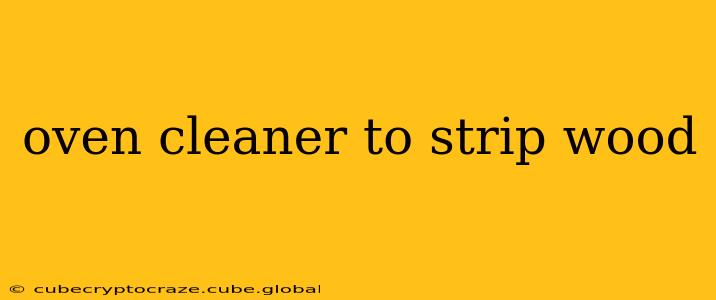Oven cleaner is a powerful chemical designed to dissolve baked-on grease and grime. While its aggressive nature might seem appealing for stripping paint or varnish from wood, it's a method fraught with danger and should be approached with extreme caution—if at all. This article explores the use of oven cleaner on wood, highlighting the risks and offering safer alternatives.
Is Oven Cleaner Safe to Use on Wood?
No, oven cleaner is generally not safe to use on wood. The highly caustic chemicals in most oven cleaners can severely damage the wood's surface, causing irreversible discoloration, pitting, and even structural weakening. The fumes are also incredibly toxic and can cause respiratory problems, skin irritation, and eye damage if not handled with proper (and often impractical) safety precautions.
What Happens When You Use Oven Cleaner on Wood?
The strong alkaline nature of oven cleaner breaks down the protective finishes on wood, but it doesn't stop there. It can penetrate the wood itself, damaging the fibers and leaving behind a dull, uneven surface. The process can also leach out tannins and other natural components, resulting in discoloration and unsightly stains. Even after thorough rinsing, residual chemicals can remain, potentially affecting future finishes.
What are the Risks of Using Oven Cleaner on Wood?
The risks associated with using oven cleaner on wood are significant:
- Damage to the Wood: As mentioned, the chemical reaction can permanently damage the wood's surface and structure.
- Health Hazards: The fumes are extremely hazardous and can cause respiratory issues, skin irritation, and eye problems. Improper ventilation can worsen these risks.
- Environmental Concerns: Oven cleaner is a harsh chemical that can pollute the environment if not disposed of properly.
What are Safer Alternatives to Oven Cleaner for Stripping Wood?
Fortunately, there are much safer and more effective methods for stripping wood:
-
Chemical Strippers: Specifically formulated wood strippers are designed to remove paint and varnish without causing significant damage to the underlying wood. They are less hazardous than oven cleaner and are available in various strengths to suit different applications. Always follow the manufacturer's instructions carefully.
-
Heat Gun: A heat gun can soften paint and varnish, making it easier to scrape off. This method requires patience and careful technique to avoid burning the wood.
-
Sanding: For stubborn finishes, sanding is a reliable option, although it can be labor-intensive. Start with coarser grit sandpaper and gradually move to finer grits for a smooth finish.
-
Mechanical Removal: Scrapers, wire brushes, and other tools can be used to remove loose paint and varnish, but this is often best used in conjunction with other methods.
How Do I Safely Dispose of Oven Cleaner?
Never pour oven cleaner down the drain. Always check your local regulations for proper disposal methods. Often, it's necessary to take it to a hazardous waste facility.
Can I Use Oven Cleaner on Specific Types of Wood?
No, regardless of the wood type (hardwood or softwood), using oven cleaner is highly discouraged. The chemical reaction is indiscriminate and will damage all types of wood.
What Should I Do If I Accidentally Use Oven Cleaner on Wood?
If you accidentally use oven cleaner on wood, immediately rinse the area thoroughly with water. Assess the damage. If the damage is superficial, you may be able to sand it out. However, if the damage is significant, you may need to replace the affected section of wood. Seek professional advice if you're unsure.
In conclusion, while the aggressive nature of oven cleaner might seem tempting for stripping wood, the risks far outweigh the benefits. Opt for safer, more effective alternatives to protect both your health and your project. Remember, safety should always be your top priority when working with any chemical.
